Beef Stew Over Rice in Chinese
The beef is braised in a rich savory broth with potatoes and carrots until super tender and flavorful. This Chinese beef stew is an easy make-ahead recipe that requires little prep and you'll have delicious dinners for the next couple of days. Freezer and meal-prep friendly. {Gluten-Free adaptable}
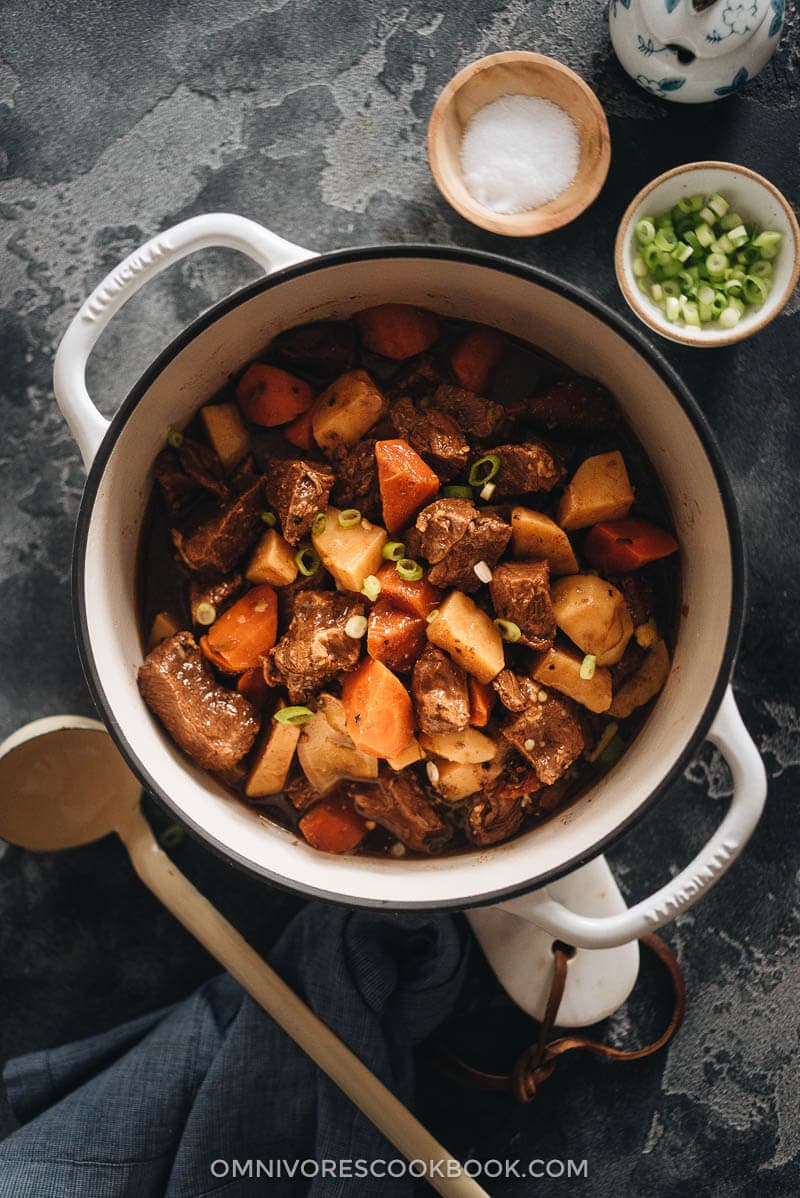
I often receive emails from readers about how challenging it is to make several Chinese dishes at the same time and serve a full meal. As you might already know, Chinese recipes tend to have long ingredient lists. Plus the recipes might require more hands-on time than many Western dishes. To tell you the truth, even my mom, who has been cooking Chinese food for the family for over 30 years, still faces the same challenge.
Her solution? Avoid cooking multiple things at a time.
It's a piece of wisdom she's repeated again and again since the first time I left home to study in Japan. She kept reminding me to make some braised meat on the weekend and freeze it in single portions, so I have a main dish to last me a week. So every day I just needed to make a vegetable dish. It's so much easier than trying to whip up a new meat dish every day.
That was nearly 15 years ago when the concept of meal prep was not yet a thing. But it's the same idea that I've been using all these years.
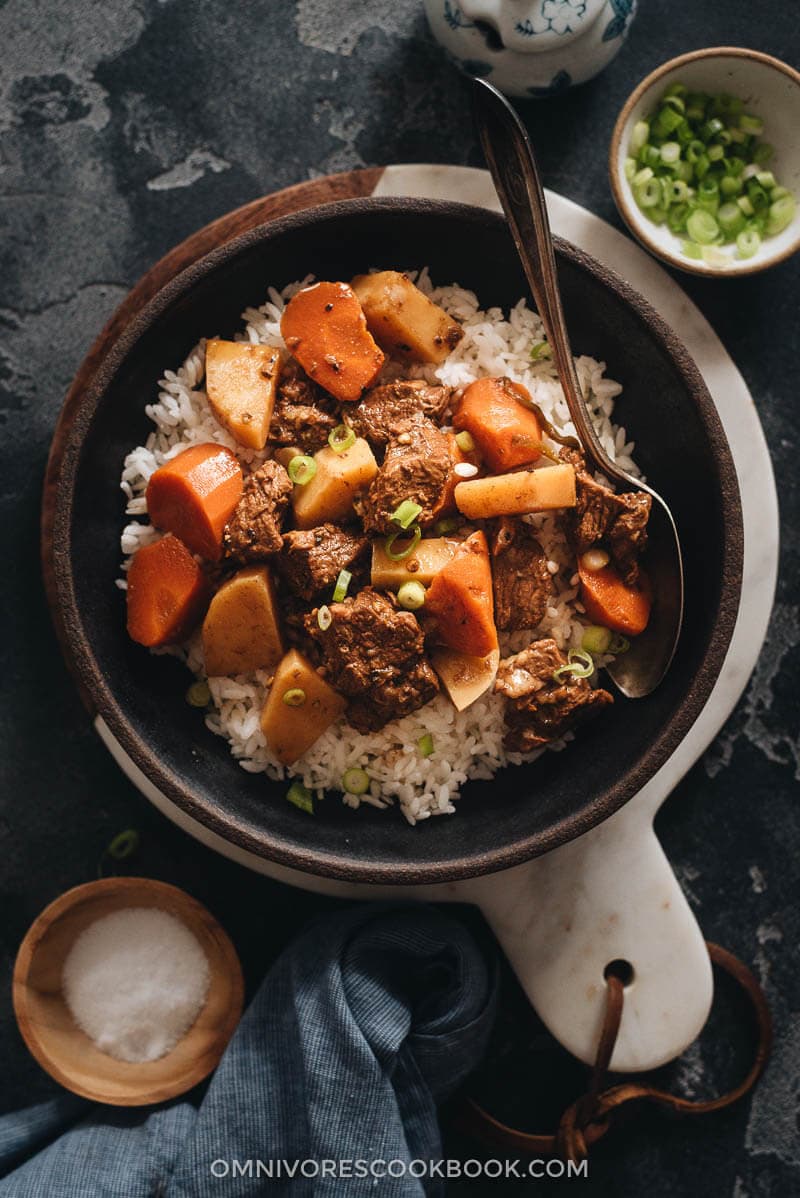
Cooking notes
1. Cut of beef
Beef chuck roast is my favorite cut to use in beef stew. The cut is usually very affordable and it yields a tender texture. Compared to the traditional Chinese beef stew, chuck roast has a much lower fat percentage. But over the years I've found that lots of my American friends prefer leaner meats. Plus it makes for a lighter, healthier stew. I've been using this cut since moving here.
Back in China, fattier stews are more popular. My mom usually uses a very fatty cut of beef brisket without trimming the fat from it. What happens is, the fat protects the lean part from overheating yet melts away during the cooking. So you get buttery melt-in-your-mouth meat in the end. If you want a fattier beef stew, try to find a very marbled cut of brisket or short ribs. In this case, you also need to braise the beef longer to get the beef tender.
2. No browning required
My mom never browns the meat before braising it. The only thing she does is boil the meat once and discard the boiling water with all the brown bits. The reason she discards the broth is to get rid of the unpleasant smell of the meat. Back in China, meat is stored and sold at room temperature at the market. Sometimes it might not be in the freshest condition when you buy it.
I found that meat in the US is much fresher. That's why I used the same approach in this recipe. But instead of discarding the boiling water, I skimmed and discarded the brown bits and saved the broth.
3. Heat control is important
One thing I learned from culinary school is, the only thing you really need to boil is pasta. You should never actually "boil" anything else, but use lower temperatures to cook them in water.
When it comes to braising meat, it's important to control the heat and not bring the broth to a full boil, which tightens the meat and makes it tougher. During the beginning stage, you do need to bring the broth to a gentle boil so it clots the blood from the meat and you can get rid of the brown bits. Once that's done, you should always keep the broth at a low simmer. This means that tiny bubbles rise to the surface of the broth here and there. The simmer will keep the beef tender. It also prevents the fat from emulsifying into the broth, which produces a clear sauce in the end.
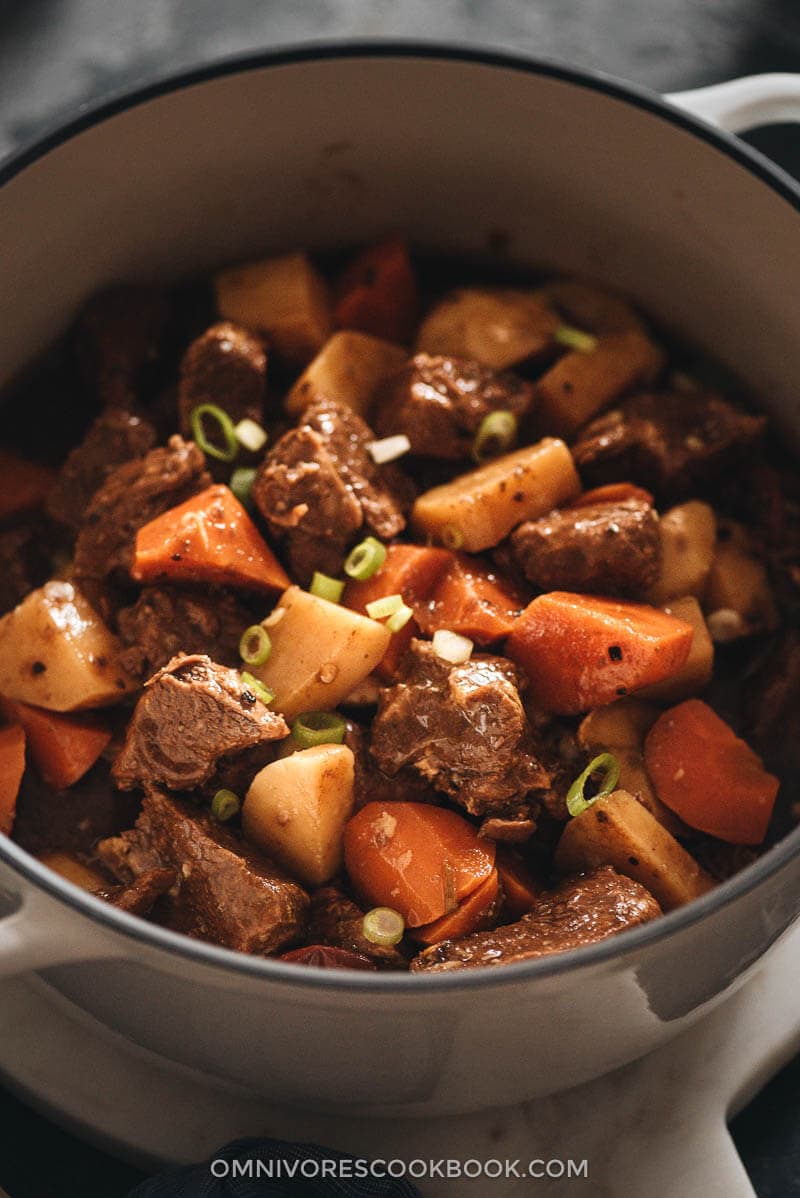
4. Sauce reduction
There are a few different approaches when it comes to sauce reduction.
- Add russet potatoes and cook them until they fall apart. The starch from the potatoes will melt into the broth and thicken it slightly.
- Use 1 tablespoon of cornstarch dissolved in 1/4 cup water to create a slurry. Drizzle it into the broth slowly and stir, until the sauce thickens. This is a quick way to create a brown gravy. I would use this method if I'm hosting a dinner party and want a nicer presentation. Note, the starch will lose its potency when reheated, so the sauce will become thin again if you heat up the leftovers.
- Bring the broth to a boil after adding the veggies. It reduces the sauce by evaporating it, plus it emulsifies some fat into the broth to thicken the sauce. This is the traditional Chinese approach. It creates a fattier and richer sauce.
You can use whichever way you prefer. For me, I simply enjoy the thin sauce generated from the recipe because I often use the leftover sauce to make braised veggies.
5. Leftover sauce
The leftover sauce has a delicious flavor of concentrated beef and seasonings, which makes a great base for cooking veggies. What I often do is:
(1) Reheat the meat and sauce in a small pan. Add more veggies (such as frozen green beans etc) and cook them together. It's just my way of adding veggies to my meals. Believe it or not, sometimes I enjoy the flavorful veggies more than the beef.
(2) Add a spoonful of leftover sauce when making a veggie stir-fry. It's a quick way to cook and season the veggies.
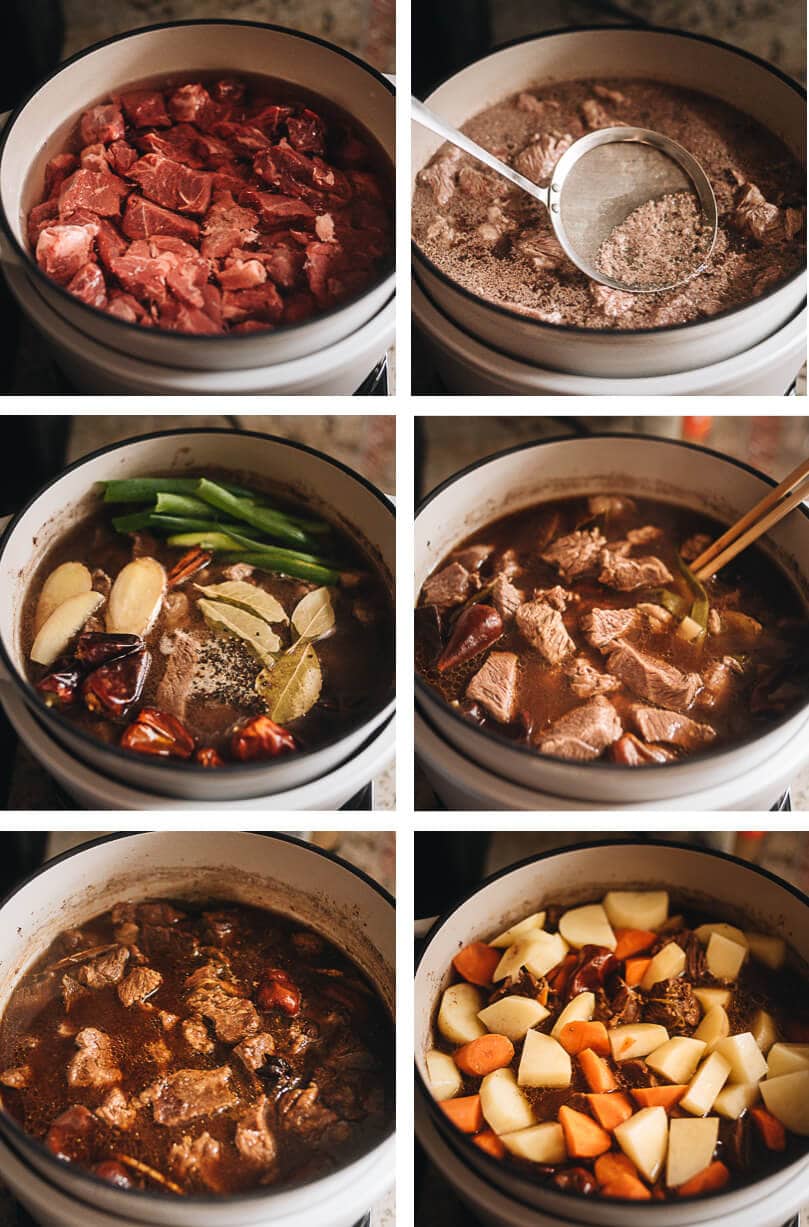
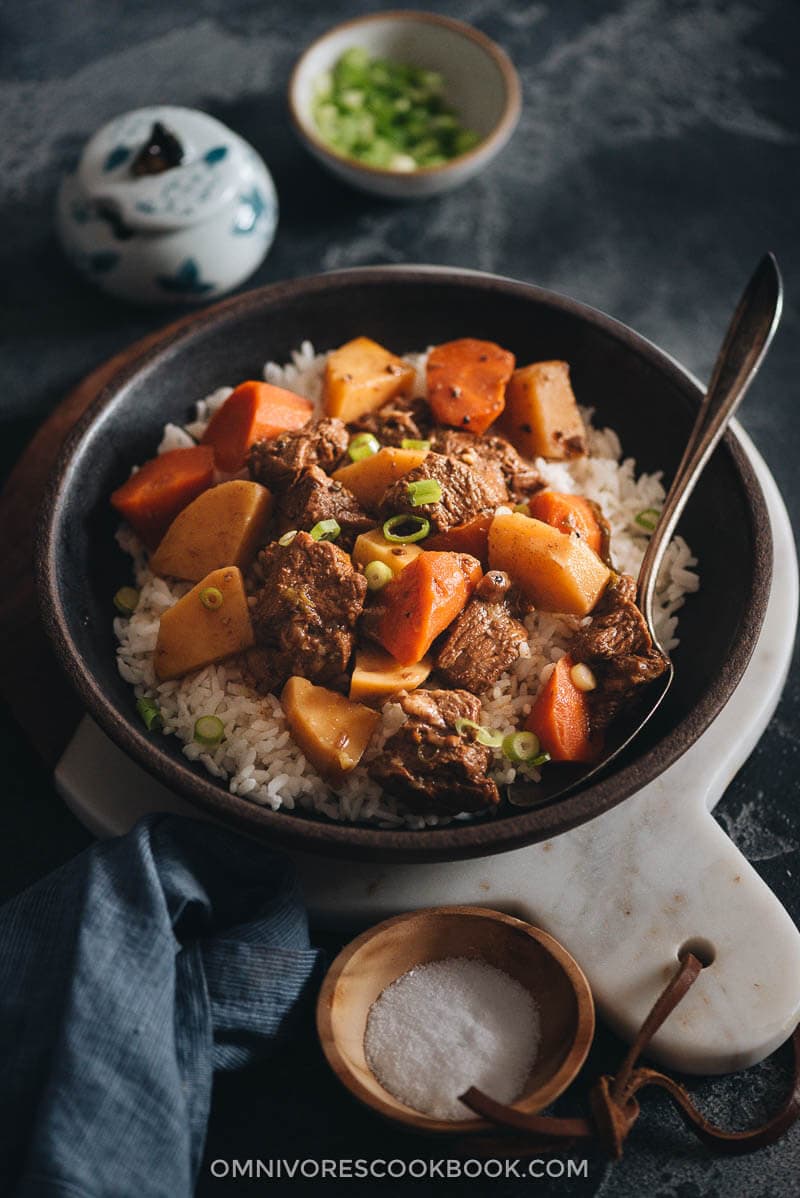
More meal-prep friendly recipes
- African Chicken (Macanese One-Pan Chicken Curry, 非洲鸡)
- Da Pan Ji (Chicken Potato Stew with Noodles, 大盘鸡)
- Mom's Best Braised Pork Ribs (红烧排骨)
- Macanese Broiled Fish with Potato and Peppers (One Pan Dinner)
- Braised Pork Shank with Black Beans
If you give this recipe a try, let us know! Leave a comment, rate it (once you've tried it), and take a picture and tag it @omnivorescookbook on Instagram! I'd love to see what you come up with.
Receive our 5-Day Chinese Cooking Crash Course & Recipe Updates! Subscribe
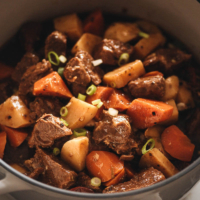
Chinese Beef Stew with Potatoes (土豆炖牛肉)
The beef is braised in a rich savory broth with potatoes and carrots until super tender and flavorful. An easy make-ahead recipe that requires little prep and you'll have delicious dinners for the next couple of days. Freezer and meal-prep friendly. {Gluten-Free adaptable} To make this dish gluten-free, use dry sherry instead of Shaoxing wine. And replace the soy sauce with coconut aminos or tamari.
Course: Main
Cuisine: Chinese
Keyword: Meal prep
Prep Time: 10 minutes
Cook Time: 2 hours 30 minutes
Total Time: 2 hours 40 minutes
- 1 (3 lbs / 1.3 kg) beef chuck roast , cut into 1.5" (3 cm) chunks
- 1/4 cup Shaoxing wine (or dry sherry)
- 6 dried chili peppers
- 1 thumb ginger , sliced
- 3 green onions , halved crosswise
- 4 bay leaves
- 1 star anise
- 1 cinnamon stick
- 1 tablespoon sugar
- 1/2 teaspoon coarsely ground black pepper
- 1/4 cup light soy sauce (or soy sauce)
- 1 tablespoon dark soy sauce (or soy sauce) (*Footnote 1)
- 1/2 teaspoon salt
- 3 carrots , cut into 2-inch pieces
- 2 medium waxy potatoes (or 1 large russet potato, quartered) (*Footnote 2)
-
Place the beef in a 4-quart (3.78-liter) dutch oven and add 4 cups of cold tap water so the water just covers the beef. Heat the pot over medium-high heat until it reaches a gentle boil. Stir occasionally to prevent the beef from sticking to the bottom of the pot. Turn to medium heat. Let it boil gently for 10 to 15 minutes. While boiling, skim the foam from the top of the broth and discard it until the broth is clear.
-
Add the Shaoxing wine, chili peppers, ginger, green onion, bay leaves, star anise, cinnamon stick, sugar, and ground black pepper. Turn to medium-low heat. Let simmer, covered, for 40 minutes.
-
Add the light soy sauce, dark soy sauce, and salt. Stir to mix well. Continue simmering uncovered for 1 hour to 1 hour 30 minutes, until the beef turns tender but not to the point of falling apart.
-
Add the carrots and potatoes. Simmer uncovered for another 30 minutes or so, until the veggies get tender.
-
Serve hot as a main over steamed rice or boiled noodles.
- Dark soy sauce adds beautiful brown color to the sauce. You can use soy sauce to replace it. The color of the dish will look lighter but it doesn't affect the taste.
- If you prefer to let the potato melt into the broth, use russet potato instead.
Serving: 1 serving , Calories: 468 kcal , Carbohydrates: 12.8 g , Protein: 31.3 g , Fat: 31.6 g , Cholesterol: 117 mg , Sodium: 541 mg , Fiber: 1.9 g , Sugar: 3.4 g
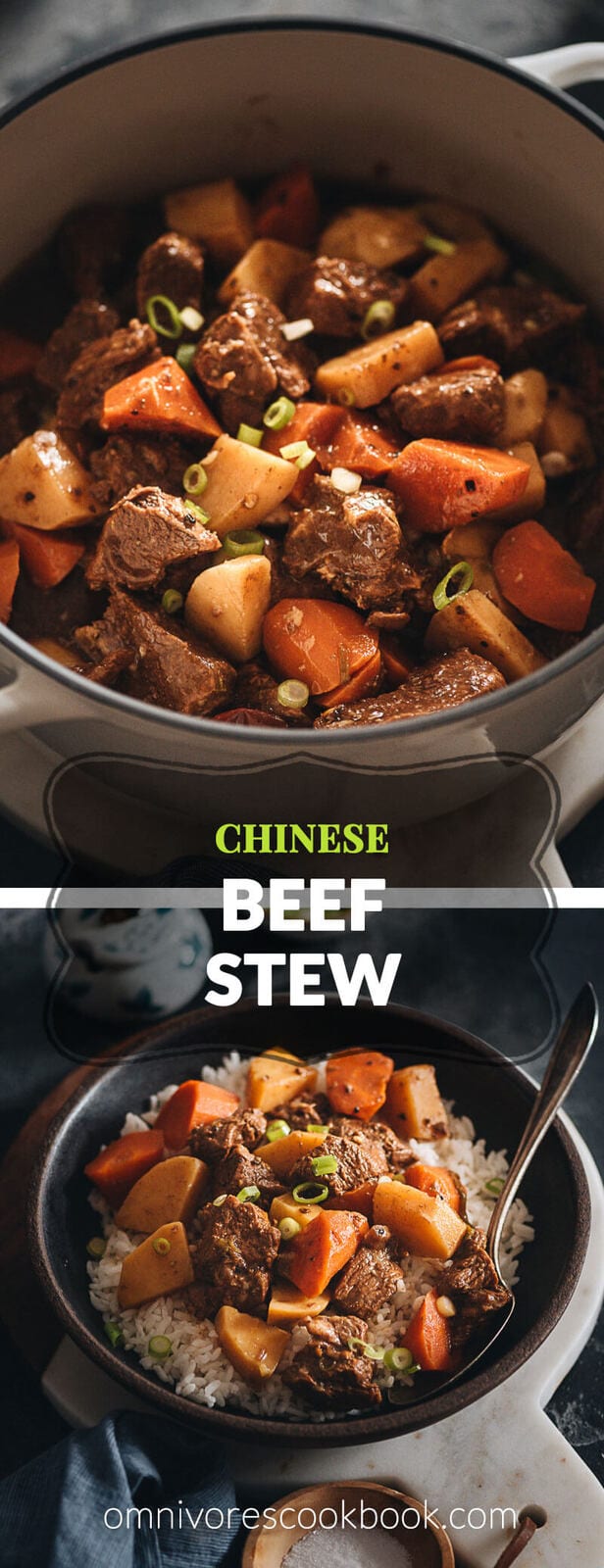
Source: https://omnivorescookbook.com/chinese-beef-stew/
0 Response to "Beef Stew Over Rice in Chinese"
إرسال تعليق